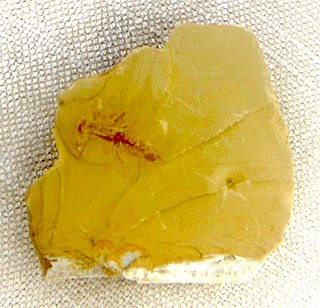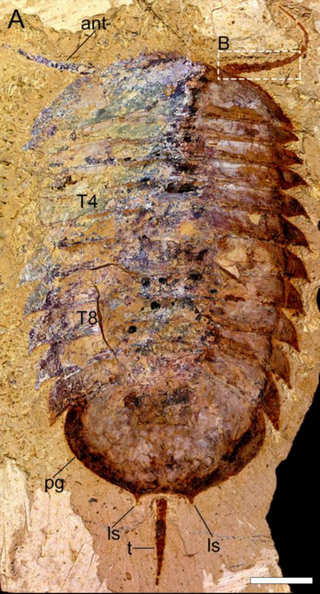
Agnostida are an order of extinct arthropods which have classically been seen as a group of highly modified trilobites, though some recent research has doubted this placement. Regardless, they appear to be close relatives as part of the Artiopoda. They are present in the Lower Cambrian fossil record along with trilobites from the Redlichiida, Corynexochida, and Ptychopariida orders, and were highly diverse throughout the Cambrian. Agnostidan diversity severely declined during the Cambrian-Ordovician transition, and the last agnostidans went extinct in the Late Ordovician.

Trilobites are extinct marine arthropods that form the class Trilobita. Trilobites form one of the earliest known groups of arthropods. The first appearance of trilobites in the fossil record defines the base of the Atdabanian stage of the Early Cambrian period and they flourished throughout the lower Paleozoic before slipping into a long decline, when, during the Devonian, all trilobite orders except the Proetida died out. The last trilobites disappeared in the mass extinction at the end of the Permian about 251.9 million years ago. Trilobites were among the most successful of all early animals, existing in oceans for almost 270 million years, with over 22,000 species having been described.

Nektaspida is an extinct order of non-mineralised artiopodan arthropods. They are known from the mid-Cambrian to the upper Silurian. Originally classified as trilobites, which they superficially resemble, they are now placed as close relatives as members of the Trilobitomorpha within Artiopoda. The order is divided into three major families; Emucarididae, Liwiidae, and Naraoiidae.

Sidneyia is an extinct arthropod known from fossils found from the Early to the Mid Cambrian of China and the Mid Cambrian Burgess Shale of British Columbia, Canada.

The Emu Bay Shale is a geological formation in Emu Bay, South Australia, containing a major Konservat-Lagerstätte. It is one of two in the world containing Redlichiidan trilobites. The Emu Bay Shale is dated as Cambrian Series 2, Stage 4, correlated with the upper Botomian Stage of the Lower Cambrian.

Arachnomorpha is a proposed subdivision or clade of Arthropoda, comprising the group formed by the trilobites and their close relatives (Artiopoda), Megacheira and chelicerates. Under this proposed classification scheme, Arachnomorpha is considered the sister group to Mandibulata.

Pancrustacea is the clade that comprises all crustaceans, including hexapods. This grouping is contrary to the Atelocerata hypothesis, in which Hexapoda and Myriapoda are sister taxa, and Crustacea are only more distantly related. As of 2010, the Pancrustacea taxon was considered well accepted, with most studies recovering Hexapoda within Crustacea. The clade has also been called Tetraconata, referring to having four cone cells in the ommatidia. This name is preferred by some scientists as a means of avoiding confusion with the use of "pan-" to indicate a clade that includes a crown group and all of its stem group representatives.

Praecambridium sigillum is an extinct organism that superficially resembles a segmented trilobite-like arthropod. It was originally described as being a trilobite-like arthropod, though the majority of experts now place it within the Proarticulata as a close relative of the much larger Yorgia. It is from the Late Ediacaran deposit of Ediacara Hills, Australia, about 555 million years ago. On average, P. sigillum had at least 5 pairs of segments, with each unit becoming progressively larger as they approach the cephalon-like head.

Diplichnites are arthropod trackways with two parallel rows of blunt to elongate, closely spaced tracks oriented approximately perpendicularly to the mid-line of the trackway. The term is more often used for the ichnofossils of this description; however, similar trackways from recent arthropods are sometimes given this name as well.

Cindarella is genus of trilobite-like Cambrian arthropod known from the Chengjiang biota of China. It is classified in the stem group of trilobites (Artiopoda) in the clade Xandarellida, along with Phytophilaspis, Sinoburius, and Xandarella.

Phytophilaspis is a phosphatized genus of trilobite-like arthropod with eyes, found in association with algal remains. It dwelt in well-lit, shallow waters.
Lamellipedia is a proposed clade of arthropods, including trilobites and their relatives (Artiopoda) and Marrellomorpha. This relationship is not consistently recovered in phylogenetic analyses.

Crustaceomorpha is a proposed clade of arthropods that includes crustaceans and numerous extinct groups. Synapomorphies for the clade are that the larval antenna is a feeding or locomotory organ, and there are six endopodal podomeres in post-antennal limbs.

Tactopoda or Arthropodoidea is a proposed clade of protostome animals that includes the phyla Tardigrada and Euarthropoda, supported by various morphological observations. The cladogram below shows the relationships implied by this hypothesis.

Furca is an extinct genus of marrellomorph arthropod known from the Sandbian stage of the Czech Republic, with a single currently described species, Furca bohemica. A tentative additional species, "Furca mauretanica": was proposed for specimens discovered in Morocco, but this species remains a nomen nudum until formally published, and probably belongs in a new separate genus.

The Artiopoda is a grouping of extinct arthropods that includes trilobites and their close relatives. It was erected by Hou and Bergström in 1997 to encompass a wide diversity of arthropods that would traditionally have been assigned to the Trilobitomorpha. Trilobites, in part due to their mineralising exoskeletons, are by far the most diverse and long lived members of the clade, with most records of other members, which lack mineralised exoskeletons, being from Cambrian deposits.

Strabopidae is the only family of the order Strabopida, an extinct group of arthropods known from the Cambrian period.

Squamacula is an extinct artiopodan arthropod from the Cambrian Series 2. The type species S. clypeata was described in 1997 from the Chengjiang biota of Yunnan, China. At the time of description there were only two known specimens of S. clypeata, but now there are at least six known specimens. In 2012 a second species S. buckorum was described from the Emu Bay Shale of Australia.

Retifacies abnormalis is an extinct arthropod that lived in the lower Cambrian. Its fossil remains have been found in the Maotianshan Shales of Yunnan, China. It is a member of the Artiopoda, and closely related to Pygmaclypeatus.

Kwanyinaspis is a genus of arthropod from the Cambrian aged Chengjiang biota of Yunnan, China. It was described in 2005 based on a single specimen, ELI-2004001. Around 6 cm long, It has twelve trunk tergites with well developed posterior facing pleural spines, along with a tail spine and ventral eyes. In the original description, it was tenatively considered a member of Aglaspidida. However, later studies have considered it a trilobitomorph, and possibly the closest known relative of trilobites.




















